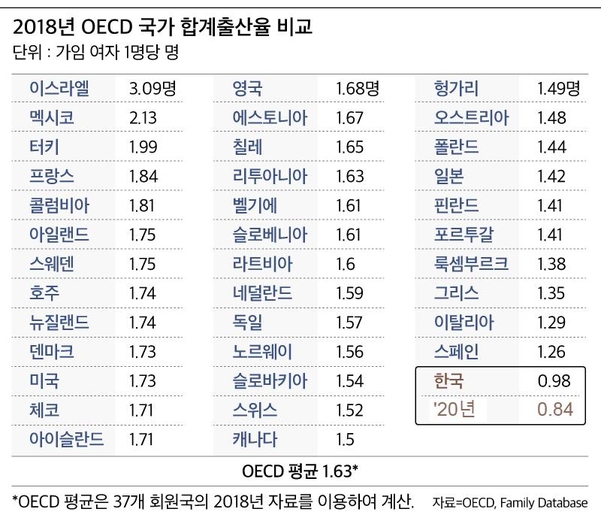Input 2021.02.24 12:00
Half of Japan’s aging country… The period of population decline may be accelerated
“I spend tens of trillions of dollars every year for low birthrate, and childcare and education policies need to be reformed”
Korea’s total fertility rate last year reached an all-time low of 0.84. Korea also ranked last for six consecutive years from 2013 to 2018 in the comparison of the total fertility rates of member countries of the Organization for Economic Cooperation and Development (OECD). Korea is the only OECD member country to become the’zero birth rate country’.
This trend is expected to accelerate the period of population decline expected in 2040. In the long-term population estimate published in 2019, the National Statistical Office has advanced the period when population decline begins from 2032 to 2029. There are concerns that if the total fertility rate is less than one person for a long period of time, the population decline may appear more steeply.

According to the ‘2020 Population Trend Survey Birth and Death Statistics’ released by the National Statistical Office on the 24th, the total fertility rate in Korea last year was 0.84. It is the lowest since birth statistics were written in 1970. This means that the average number of births a woman expects to have in her fertile period (15-49 years old) is less.
The total fertility rate has been maintained at 1.17 in 2016 and 1.05 in 2017. However, after falling below 1 for the first time in 2018 (0.98), it has remained at the 0 level for 3 consecutive years.
Last year, the number of births fell 3,300 (10%) compared to the previous year to 272,400. This is the first time that the number of births has fallen to 200,000. The number of births fell to 300,000 for the first time in 2017 (357800), and has been kept to 300,000 for 3 years.
The OECD annually surveys and reports the total fertility rates of 37 member countries. The total fertility rate required to maintain the status quo is 2.1. However, Korea is less than half of this. Far from the average of the OECD member countries (1.63), it is the overwhelming last, which is less than the ultra-low fertility standard (1.3).
The country with the highest total fertility rate was Israel (3.09). This means that one woman has an average of three children. It is interpreted by the influence of the Jewish culture and religion that values family. Mexico (2.13), Turkey (1.99), France (1.81) and Colombia (1.81) were followed.
The total fertility rates of Japan (1.42) and Greece (1.35), which are known as representative low birthrate countries, were also higher than those of Korea. According to OECD statistics, Spain (1.26 people) was the second country with the lowest total fertility rate just after Korea. However, even in Spain, the gap with Korea was wide.
◇ The National Statistical Office, inevitable to correct long-term population outlook “The number of births is falling faster than expected”
If the combined fertility rate is 1 or less for a long period of time, the trend of population decline may steepen. According to the long-term population estimate released by the National Statistical Office in 2019, the population of Korea is expected to decrease from 2029 after peaking at 51.94 million in 2028. It is three years ahead of 2032, which was announced in the 2016 fall.

The National Statistical Office predicted that the total fertility rate would decline to 0.86 in 2021 and then rebound to 1.11 in 2028 and 1.27 in 2040. It is predicted that the number of newborns will break the wall of 300,000 in 2020, and then recover to the 300,000 level again in 2022.
An official from the National Statistical Office said, “The decline in the number of births is faster than the original estimate.” It was a serious situation.”
The government has invested huge budgets such as 26.3 trillion won in 2018, 32.3 trillion won in 2019, and 37.600 trillion won last year, saying that it will overcome the low birth rate problem. Local governments are also encouraging childbirth by expanding childbirth subsidies. However, experts point out that the trend of population decline cannot be reversed with child allowances and childbirth incentives.
An official from an economic research institute said, “It is difficult to induce couples to have more children only with cash support from the government and local governments.” “There is a need to change the idea to have a legal and institutional environment.”
